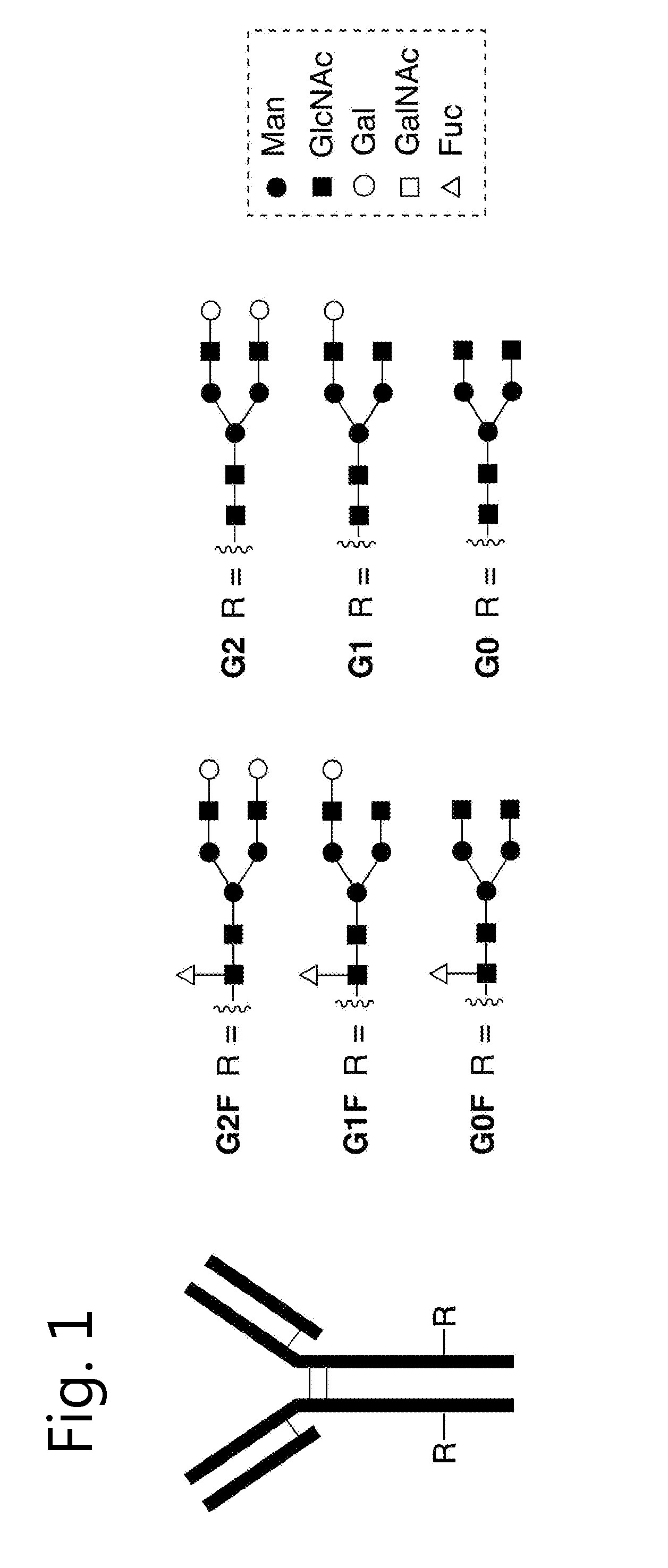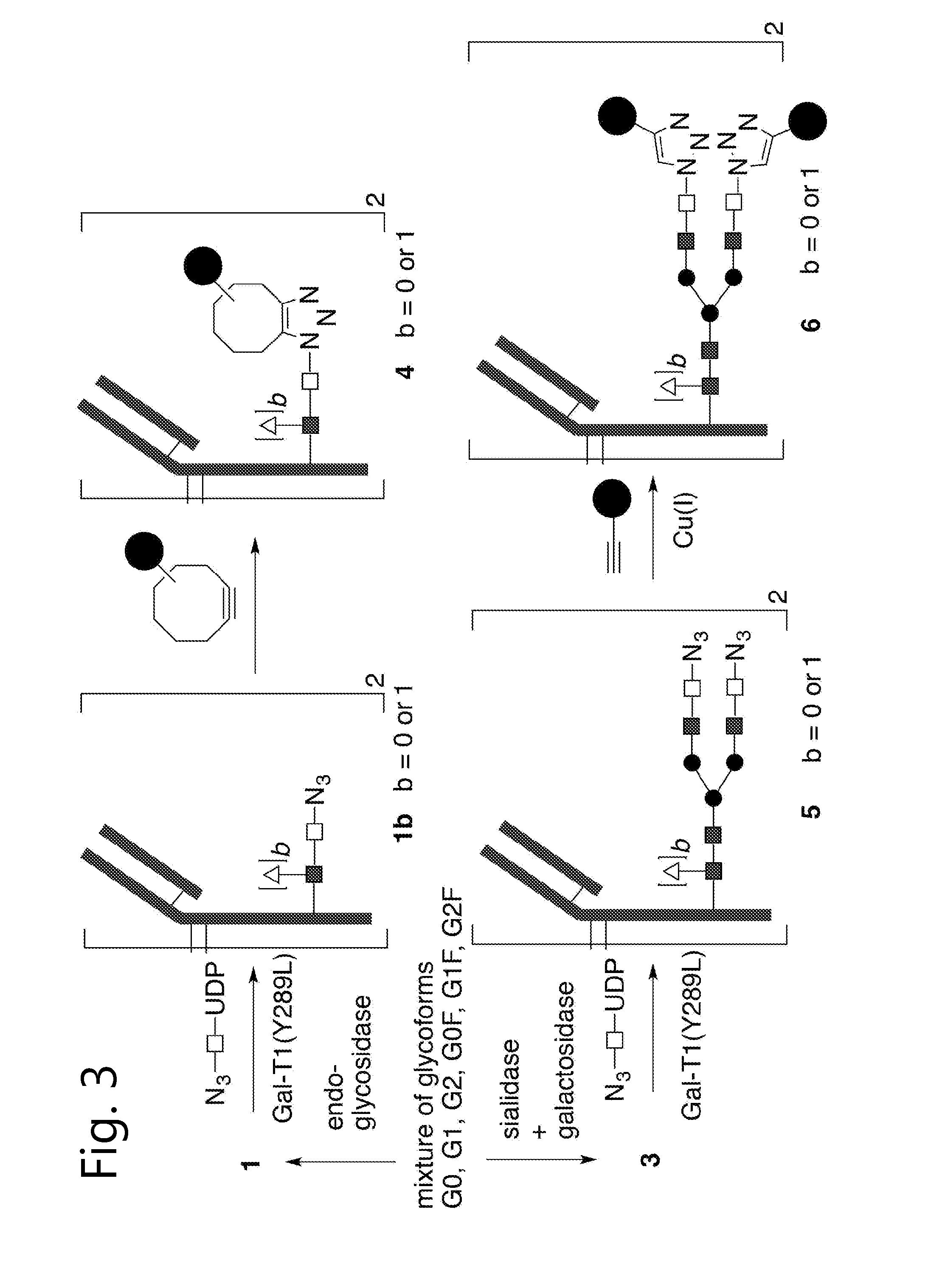Modified glycoprotein, protein-conjugate and process for the preparation thereof
a technology of modified glycoproteins and protein conjugates, applied in the field of modified glycoproteins, can solve the problems of low site control of conjugation, low efficiency of incorporation of 6-thiofucose, and inability to achieve random conjugation of antibodies
- Summary
- Abstract
- Description
- Claims
- Application Information
AI Technical Summary
Benefits of technology
Problems solved by technology
Method used
Image
Examples
example 1
Synthesis of BCN-Biotin Conjugate (33)
[0399]To a solution of 2,2′-(ethylenedioxy)bis(ethylamine) (11.78 mL, 80.5 mmol) in DCM (200 mL) was added BCN-OSu 23 (7.82 g, 26.8 mmol) in DCM (100 mL) dropwise over 3 h. After complete addition the mixture was stirred for 10 min followed by washing with saturated aqueous NH4Cl (3×200 mL). The organic layer was dried over Na2SO4, filtrated and concentrated in vacuo. Flash column chromatography (DCM:MeOH 99:1-93:7+1% Et3N) gave product BCN-PEG2-NH2 (5.95 g, 54.7 mmol, 68%). 1H-NMR (300 MHz, CDCl3) δ 5.38 (s, 1H), 4.13 (d, J=8.1 Hz, 2H), 3.59 (s, 4H), 3.56-3.50 (m, 4H), 3.35 (q, J=5.1 Hz, 2H), 2.88 (t, J=5.1 Hz, 2H), 2.32 (br s, 2H), 2.27-2.15 (m, 6H), 1.62-1.42 (m, 2H), 1.33 (qn, J=8.7 Hz, 1H), 0.97-0.85 (m, 2H). 13C-NMR (CDCl3, 75 MHz) δ 156.4, 98.3, 68.7 (2C), 62.2, 45.5, 40.3, 40.2, 28.6, 20.9, 19.6, 17.3. HRMS (ESI+) calcd for C17H28N2NaO4 (M+Na+) 347.1947, found 347.1952.
[0400]To a solution of BCN-PEG2-NH2 (0.80 g, 2.47 mmol) in DCM (25 mL...
example 2
Synthesis of BCN-PEG2-C(O)OSu Carbonate (35)
[0401]A solution of N,N′-disuccinimidyl carbonate (1.82 g, 7.11 mmol) in MeCN (50 mL) was prepared under argon. A solution of BCN—PEG2-OH (1.0 g, 3.55 mmol) in MeCN (50 mL) was added dropwise over 3 h. After 1 h of additional stirring, the reaction mixture was poured out in a mixture of EtOAc / H2O (150 mL / 150 mL). The layers were separated and the aqueous layer was extracted with EtOAc (150 mL). The combined organic layers were dried (Na2SO4) and concentrated. The residue was purified via column chromatography and the desired product 35 was obtained as a colorless oil (0.79 g, 2.81 mmol, 79%). 1H NMR (CDCl3, 400 MHz) δ (ppm) 5.19 (bs, 1H), 4.50-4.42 (m, 2H), 4.16 (d, J=8.0 Hz, 2H), 3.77-3.71 (m, 2H), 3.57 (t, J=5.1 Hz, 2H), 3.39 (dd, J=10.5, 5.4 Hz, 2H), 2.85 (s, 4H), 2.35-2.16 (m, 6H), 1.65-1.51 (m, 2H), 1.41-1.34 (m, 1H).
example 3
Synthesis of BCN-vc-PABA-MMAF (36)
[0402]To a solution of Val-Cit-PAB-MMAF.TFA (17.9 mg, 14.3 [mop in DMF (2 mL) was added BCN-PEG2-C(O)OSu (17.9 mg, 14.3 μmol) (35) as a solution in DMF (0.78 mL) and triethylamine (6.0 μL). The product (7 mg, 5 μmol, 35%) was obtained after purification via reversed phase HPLC (C18, gradient H2O / MeCN 1% AcOH). LRMS (HPLC, ESI+) calcd for C74H114N11O18 (M+H+) 1444.83, found 1445.44.
PUM
 Login to View More
Login to View More Abstract
Description
Claims
Application Information
 Login to View More
Login to View More - R&D
- Intellectual Property
- Life Sciences
- Materials
- Tech Scout
- Unparalleled Data Quality
- Higher Quality Content
- 60% Fewer Hallucinations
Browse by: Latest US Patents, China's latest patents, Technical Efficacy Thesaurus, Application Domain, Technology Topic, Popular Technical Reports.
© 2025 PatSnap. All rights reserved.Legal|Privacy policy|Modern Slavery Act Transparency Statement|Sitemap|About US| Contact US: help@patsnap.com



